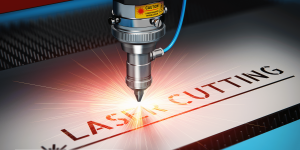Introduction
CNC cutting machines are power tools that use a computer program to direct the cutting of the material. Laser cutters, waterjet cutters, and plasma cutters are among the most frequently used CNC cutting machines in the industry. The determination of which one is suitable for your case depends on the kind of material, thickness, and the number of pieces to be cut. In this guide, we will compare laser, Waterjet, and plasma CNC cutting machines based on the factors to consider.
Cutting Capabilities
Laser Cutting
– Utilizes a high-power laser beam to melt or vaporize the material.
– Ideal for cutting sheet metal, plastics, wood, acrylics, fine materials
– Thickness range: Stainless steel or aluminum up to 0. 5 mm, acrylic up to 13mm
– High accuracy is achieved, mainly where small kerf widths of 0. 1 mm and below are used.

Waterjet Cutting
– Utilises a high-pressure water jet that contains an abrasive to cut away at the material.
– Can slice through almost any material, be it metal, stone, glass, or composites.
– The edges of the disks show no sign of heat damage, and the disks do not appear to be warped.
– Thickness range: thick sheet up to 0. 8 mm aluminum and up to 200 mm granite
Plasma Cutting
– Utilizes a narrow plasma arc to heat and vaporize the material.
– Suitable for cutting all kinds of metal with superb surface finish.
– Medium accuracy up to the kerf width of 1mm
– Thickness range: Thin up to 50mm thick 0. 5mm sheet metal up to 50 mm steel plate
Cut Quality
Specifically, the type of cut edge imparted varies depending on the laser, Waterjet, and plasma cutting. Lasers provide the best cut-on sheet materials with thin kerf and minimal heat-affected zones. The reductions of Waterjet however produce almost no heat related damage but the pressure causes a more uneven edge. Plasma cutting melts the material edge and leaves some oxidation and roughness with the cut edge.
Laser and possibly Waterjet are preferred for applications where edge appearance is crucial, like decorative metal panels. Plasma cutting is rarely used to finish parts.
Materials Compatibility
Lasers can be used on wood, plastic, fabric, leather, and thin, non-shiny metals. Versatility of lasers makes it possible to cut through foam, acrylics and other delicate electronics using a variety of wavelengths.
Waterjets can cut through virtually any material including metals, stone, glass, composites, rubbers, foams, etc. None of the material is affected by heat making waterjets ideal for finished products.
Plasmas can sever all forms of conductive metals such as the stainless steel, aluminium, brass and copper. Thicker metals are what plasma typically handle. It should also be noted that not all materials can be plasma cut, for example, wood or glass.

Within these are speed, precision and cut size.
Today’s CNC plasma and laser machines provide equal accuracy with a step of 0. 1 mm for details. Waterjet can only cut to a precision of about 0. 3 mm features.
When it comes to small and delicate cuts, control is of utmost importance and laser gives the best edge. Slower cutting speeds are observed for waterjet and plasma cuts on small curves or holes.
When it comes to necessary more significant cuts plasma is much faster than laser or water jet because of the power. The plasma can achieve up to 100 ipm as compared to 10-30 ipm for laser and Waterjet.
Cost Comparison
Plasma cutters are the most inexpensive CNC cutting devices in terms of equipment and utilization. Lasers are relatively cheap and outlast consumables. Lasers are slightly more costly due to high energy consumption and lens/mirror replacements. Waterjets use costly abrasives thus increasing operating expenses.
In summary:
– Plasma: fast and inexpensive for cutting thick metals.
– Laser: High dimensional accuracy and edge surface finish of sheet materials
– Waterjet: A generalist with no heat effects but is slower
Making the Choice
The material type, thickness, edge quality, precision, and cost influence the choice of a CNC cutting machine. Think of the current and future projects or products that you will manufacture to choose the appropriate system. For many operations, it makes the most sense to own multiple machines or to outsource specialty cuts to another machine. There are specific CNC cutting machines that can be used to cut prototypes and scaled complete production parts.
